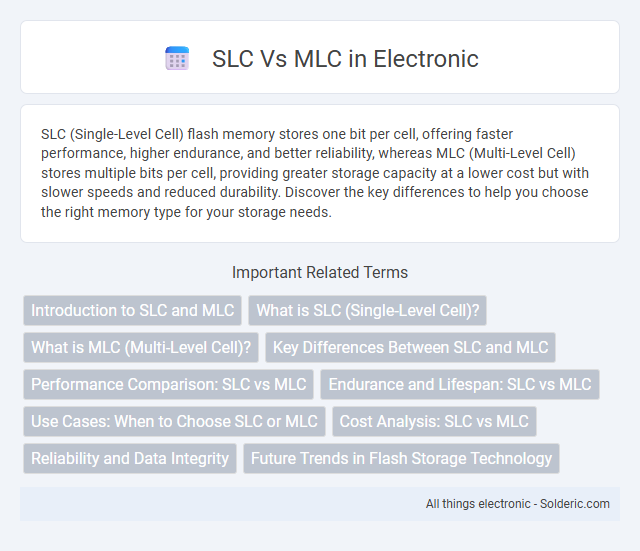SLC (Single-Level Cell) flash memory stores one bit per cell, offering faster performance, higher endurance, and better reliability, whereas MLC (Multi-Level Cell) stores multiple bits per cell, providing greater storage capacity at a lower cost but with slower speeds and reduced durability. Discover the key differences to help you choose the right memory type for your storage needs.
Comparison Table
| Feature | SLC (Single-Level Cell) | MLC (Multi-Level Cell) |
|---|---|---|
| Data Storage | Stores 1 bit per cell | Stores 2 bits per cell |
| Speed | Faster read/write speeds | Slower read/write speeds |
| Endurance | Higher endurance (up to 100,000 P/E cycles) | Moderate endurance (around 3,000 to 10,000 P/E cycles) |
| Cost | Higher cost per GB | Lower cost per GB |
| Reliability | More reliable with lower error rates | Less reliable with higher error rates |
| Use Cases | Enterprise storage, high-performance SSDs | Consumer SSDs, budget-friendly options |
Introduction to SLC and MLC
Single-Level Cell (SLC) and Multi-Level Cell (MLC) are two types of NAND flash memory used in solid-state drives (SSDs) and other storage devices. SLC stores one bit of data per cell, offering higher endurance, faster write speeds, and greater reliability compared to MLC, which stores multiple bits per cell to increase storage density and reduce cost. While SLC is preferred in enterprise and high-performance applications, MLC is commonly used in consumer-grade devices where capacity and cost efficiency are prioritized.
What is SLC (Single-Level Cell)?
SLC (Single-Level Cell) is a type of NAND flash memory storing one bit of data per cell, resulting in faster read/write speeds and higher durability compared to other memory types. Its simplified design enables lower error rates and longer lifespan, making it ideal for enterprise storage, caching, and industrial applications where reliability is crucial. Your choice of SLC-based storage ensures enhanced performance and endurance in mission-critical environments.
What is MLC (Multi-Level Cell)?
MLC (Multi-Level Cell) is a type of NAND flash memory that stores two or more bits of data per cell by utilizing multiple charge levels. This technology increases storage density and reduces cost per gigabyte compared to SLC (Single-Level Cell), which stores only one bit per cell. MLC is commonly used in consumer SSDs and memory cards where higher capacity at a lower price is prioritized over the maximum endurance and speed of SLC.
Key Differences Between SLC and MLC
SLC (Single-Level Cell) stores one bit per cell, offering faster speeds, higher endurance, and greater reliability compared to MLC (Multi-Level Cell), which stores two or more bits per cell to increase storage density and reduce cost. Your choice between SLC and MLC affects performance, with SLC ideal for enterprise environments requiring durability and MLC suitable for consumer devices prioritizing capacity. Key differences include SLC's superior write cycles, lower error rates, and higher price point versus MLC's enhanced storage efficiency and cost-effectiveness.
Performance Comparison: SLC vs MLC
SLC (Single-Level Cell) flash memory offers faster read and write speeds compared to MLC (Multi-Level Cell) due to storing one bit per cell, resulting in lower latency and higher IOPS (Input/Output Operations Per Second). MLC stores multiple bits per cell, increasing data density but causing slower performance and higher error rates under intensive workloads. Enterprise-grade SSD benchmarks confirm SLC's superior endurance and throughput, making it ideal for high-performance applications.
Endurance and Lifespan: SLC vs MLC
SLC (Single-Level Cell) flash memory offers significantly higher endurance and longer lifespan compared to MLC (Multi-Level Cell) due to its ability to store one bit per cell, reducing wear and error rates. MLC stores multiple bits per cell, increasing write cycles and error susceptibility, which shortens overall lifespan and reduces write endurance. Your choice between SLC and MLC impacts device reliability, especially for applications requiring frequent, high-volume write operations.
Use Cases: When to Choose SLC or MLC
SLC (Single-Level Cell) flash memory is ideal for enterprise-grade applications requiring high endurance, reliability, and fast write speeds, such as data centers and mission-critical systems. MLC (Multi-Level Cell) memory offers greater storage density at a lower cost, making it suitable for consumer devices and general-purpose storage where endurance and speed are less critical. Choose SLC for workloads involving frequent write operations and MLC for cost-effective storage with moderate performance needs to optimize your system's efficiency and budget.
Cost Analysis: SLC vs MLC
SLC (Single-Level Cell) NAND flash memory incurs a higher production cost due to its simpler data storage mechanism, offering increased reliability and endurance compared to MLC (Multi-Level Cell). MLC stores multiple bits per cell, reducing manufacturing expenses and resulting in a lower cost per gigabyte, making it a cost-effective choice for consumer-grade solid-state drives. The trade-off between SLC's premium price and MLC's affordability centers on durability and performance requirements in various storage applications.
Reliability and Data Integrity
SLC (Single-Level Cell) flash memory offers higher reliability and superior data integrity compared to MLC (Multi-Level Cell) due to storing one bit per cell, which reduces error rates and wear. MLC stores multiple bits per cell, increasing error susceptibility and requiring more advanced error correction algorithms to maintain data integrity. Choosing SLC ensures your critical applications benefit from extended endurance and consistent performance under heavy write and erase cycles.
Future Trends in Flash Storage Technology
Emerging trends in flash storage technology reveal a gradual shift from Single-Level Cell (SLC) to Multi-Level Cell (MLC) and beyond, driven by increasing demands for higher density and cost efficiency. Innovations in 3D NAND architecture and advanced error correction algorithms are enhancing MLC endurance and performance, narrowing the traditional reliability gap with SLC. Industry projections indicate that future storage solutions will leverage QLC and PLC variants, combining enhanced capacity with sustained durability through AI-driven wear leveling and predictive maintenance.
SLC vs MLC Infographic

 solderic.com
solderic.com